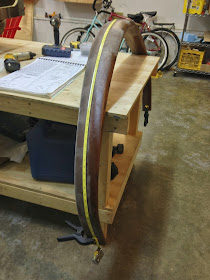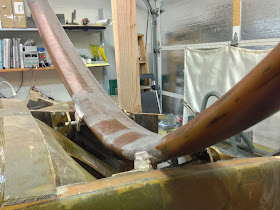The other “missing half inch”(6.6 hrs)
The back cover of the plans is the only place where the Water Line (WL) for the main gear axles appears. The drawing shows that the axles should be located at Fuselage Station (FS) 110.5, and WL-22 (X and Z directions if you like).
 |
| Main gear axles location |
Talking to other builders I realized that few were aware of this WL requirement, certainly due to its obscure location, so it appears that many builders placed the square aluminum tabs holding the axles at the end of the gear legs, like this drawing shows, and “called it a day”.
 |
| Square aluminum tab mounted on the gear bow |
The point here is that there must be a lot of planes that have been flying just fine for decades without a precise vertical positioning of the axles, and this leads me to believe that it might not be as critical a requirement as I previously thought.
Nevertheless, in the last blog post I was running short of gear bow height, so I needed to understand why.
Just to be sure I didn’t purchase the wrong item, I called Featherlite (makers of my bow) to compare measurements. Their gear turned out to be 90.3” (2.3 m) long, same as mine.
 |
| Measuring the bow size |
 |
| Bow length in inches |
Then it hit me!
If you remember, in Ch. 5 - Landing Gear mounts - Part 1, LPC#45 modified the gear extrusions by moving the 3/8" (0.95 cm) holes in all four extrusions up 0.4" (1 cm), thereby moving the entire main gear up 0.4".
So, the vertical reference for the axles shown in the back cover as WL-22 is incorrect. The proper main gear axles vertical reference should in fact be WL-21.6, to reflect the fact that the whole gear was raised due to LPC#45.
 |
| Adjusted main gear axles location |
Armed with this new realization, a more appropriate geometry for the gear axles would be as in the next picture.
 |
| New Water Line still falls short |
As you can see, even though I recovered 0.4” using the new WL-21.6, I am still coming up short with the placement of the gear axles.
Half of the now reduced 0.8” (2 cm) height difference, between the actual and the desired axle location, was of my own doing, since the 2” (5 cm) wider fuselage allowed the gear bow to drop 0.4” (1 cm) further than it would have on a standard width fuselage.
 |
| Amount of gear height loss due to fuselage widening |
All of the previous pictures were taken while I was still erroneously measuring the 15” (38 cm) spar-to-axle distance from the front of the firewall (something I discussed 2 posts ago). Measuring from the back of the wing spar at BL26.75 forced me to rotate the gear backward, thus recovering 0.2” in height.
To compensate for the heavier IO-320 engine, I rotated the gear bow even further back, moving the gear axles rearward another 0.5” (1.3 cm) to FS 211.0. This way I was able to recover an additional 0.2” (0.5 cm). My good friend Ary ran some quick calculations on it, and as expected there seemed to be no real issues there.
Finally, using foam blocks as shims while trying to adjust the gear height, I ended up lengthening the gear bow attachment tabs up to a maximum of 0.3” (0.76 cm), roughly 20% for the longest one. This is not something I measured ahead of time, but it sort of happened automatically, since the sharp tips of the plywood tabs were chipped beyond recognition, and mostly gone by this time, and the small gaps got filled with Bondo.
If you add it all up, It would seem that I am still missing 0.1” (0.25 cm), but I decided to leave that one be, since trying to take precise measurements in this area is very difficult, and hardly repeatable. Once the gear tabs are glassed, I’ll mount the gear bow back on the fuselage, and check to see exactly where my axles end up. Not a very scientific method, I know, but I should be pretty close at this point, and I’m getting tired of all of these “treasure hunts” you have to embark on, in order to replicate the plans' dimensions.
 |
| Main gear axles location at WL-21.6 restored |
Of all my modifications, lengthening the gear tabs is not one I really wanted to make, because there are strong forces acting on them during takeoff and landing, and the longer they are, the more leverage these forces will have to flex the tabs.
Luckily, since the gap outboard of the tabs is supposed to be filled with a flox spacer (a later modification designed to prevent the main gear bow from sliding on the tubes), I had enough room to easily increase the tabs’ thickness by 50%, in order to compensate for the taller tabs, while at the same time reducing the need for a thick flox spacer.
My gear tabs will now be 108 plies of fiberglass, compared to the original 72 plies.
With the geometry decided upon, it was time to lock it in by “Bondoing” the plywood tabs to the fiberglass bow.
 |
| Right rear tab attached to the bow with Bondo |
 |
| Left rear tab attached to the bow with Bondo |
 |
| Front tabs attached to the bow with Bondo |
 |
| Another look at the rear tabs |
Once dried, I removed the entire bow from the fuselage.
 |
| Tabs and bow removed together from fuselage |
Next, I glued foam scraps a to act as reference marks, and scribed plus marked a corresponding mark on the tubes, before removing them.
 |
| Left tube and foam reference marked |
 |
| Right tube and foam reference marked |
 |
| Right tube removed to prepare for glassing |
 |
| Left tube removed and foam reference firmly in place |
Lastly, I took some time to sand the Bondo smooth...
 |
| Bondo sanded down |
 |
| Wooden tab and Bondo smoothed |
 |
| Fiberglass will lay flat over the smooth transition |
... and taped over them in preparation for glassing.
 |
| Duct tape will allow the wooden tab to be removed after glassing |
 |
| More duct tape covered the remaining tabs |

No comments:
Post a Comment